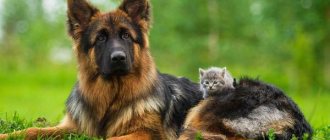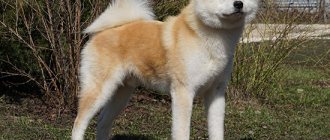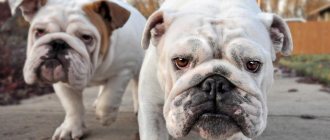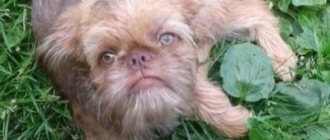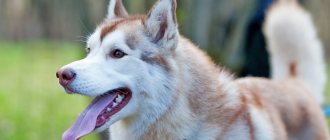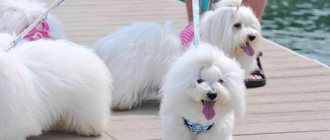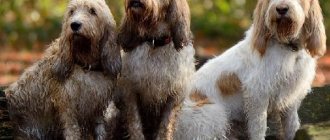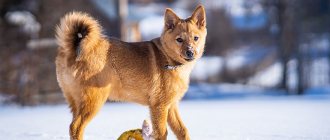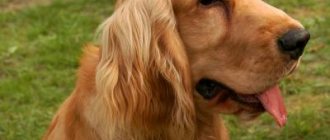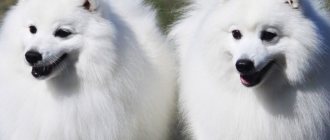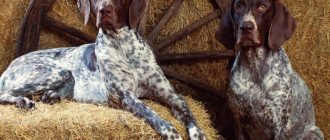Video
* We invite you to watch a video about the Great Dane . In fact, in front of you is a playlist in which you can select and watch any of 20 videos about a given dog breed by simply clicking on the button in the upper right corner of the window. In addition, the material contains quite a lot of photos. By looking at them you can find out what a Great Dane looks like.
In this article:
|
Rate the material!
[Total votes: 2 Average: 3]
At the first meeting, the Great Dane may seem like a very dangerous animal due to its impressive size. This is exactly the case when appearances are deceptive and behind the stern appearance hides a very devoted friend who subtly feels his owner and does not tolerate loneliness well. The German giant is a true aristocrat in the world of dogs, his majestic beauty will impress everyone.
How to buy an English bulldog puppy
It is recommended to buy a puppy from a good breeder or kennel. This guarantees the purity of the breed and the absence of congenital pathologies. A purebred puppy will cost 20-35 thousand rubles, and offspring from exhibition winners will cost from 40 thousand. You can buy a puppy without documents for 5,000 rubles, but it may turn out to be a mixed breed or sick.
Buy a dog at the age of 1.5-3 months. When choosing, you need to pay attention to the documents: there must be a pedigree, a veterinary passport. It is also important to examine the dog's appearance. The coat should be smooth, shiny, eyes and ears clean, without discharge. The paws are thick, widely spaced and even, the belly is not bloated. The puppy should be active, cheerful, and not cowardly. Bitches are more flexible and easier to train. And males are more courageous and active.
Photos show what the puppies look like:
History of the origin of Great Danes
The Great Dane breed belongs to a large group of Great Danes and is considered the oldest breed. The common ancestor of these giants is the Tibetan Great Dane. The first documented evidence of the existence of this breed dates back to the 12th century BC, their images were found on rune stones.
Tibetan dogs were extremely popular in many Asian countries; for centuries they were used to guard monasteries, protect herds from predators, and hunt. Over time, powerful animals spread throughout the world. Many remains of these dogs have been found at sites of ancient battles, which confirms that the animals accompanied troops during campaigns and were used as weapons.
Images of Great Danes adorned the coins of Ancient Greece. Even Aristotle was impressed by the power of war dogs, which he mentioned in his treatises. For his military services during the battle of the Peloponnese, a monument was erected to him in Corinth.
For many decades there has been confusion over the names: Great Dane, Great Dane, or French Dog, and so on. This was one type of dog, but due to the many differences in phenotype, they could not be called one breed. Only at the end of the 18th century, German dog breeders created, based on the existing diversity of mastiffs, one breed that combined all the best characteristics and qualities of dogs from different regions. In 1880, a breed standard for the Great Dane appeared.
After the Second World War, the number of these animals and productive lines were restored through the efforts of many countries, so most of the nurseries were destroyed.
Story
There is historical evidence that 2.5 thousand years ago the ancestors of modern English mastiff dog breeds already lived in the Asian mountains. The bas-relief of the palace of the ruler Ashurbanipal, located in Babylon, depicts very similar, only taller and thinner dogs (there is little food there). In the desert they hunted lions near the Tigris River.
Experts believe that the ancestor of the English mastiffs was the Tibetan mastiff. Marco Polo, who lived from 1254 to 1324, talked about one khan who had 500 mastiffs and used them in war and hunting.
The commander of Rome, Hannibal, when he crossed the Alps with his army, took 2 hundred mastiffs. The males flogged local females and in the future the St. Bernard breed (Alpine Mastiffs) arose here. Mastiff blood flows in the veins of Chow Chows and even Pugs, which are considered a dwarf version of Mastiffs. Large dogs living in France and Spain or in Turkey and the Balkans owe their size to mastiffs.
These dogs guarded English castles at night. Henry VIII gave Charles V, the Spanish king, 400 mastiffs to fight in the war. Mastiffs have been bred for many generations by the Leigh family, who live in Limehall. It's in Cheshire. The castle was given to them by King Richard II, who reigned from 1377 to 1399. The kings of those times gave each other mastiffs.
The Celts often took mastiffs with them to war. The Romans, after defeating the British, transported mastiffs with them and this is how they came to Italy. There they guarded prisons with prisoners, estates and took an active part in gladiatorial battles.
During the reign of Elizabeth, the nobility had fun and went with mastiffs to hunt tigers and bears. The bullying was soon banned. Dogs continued to be bred by the Earl of Herrington and the Dukes of Sutherland and Devonshire, other nobility.
Dog shows in England became a popular show in the 2nd half of the 19th century. People with the means kept and bred mastiffs. The Kennel Club in England registered these dogs and later issued pedigrees to the descendants.
During hostilities, mastiffs transported heavy ammunition. In America they were guards on plantations. The breed was nicknamed "butcher's dogs." It was the butchers who had a lot of trimmings that were fed to the dogs.
By the end of the 19th century, the breed became less and less popular. The dogs were exported to America. The First World War was a difficult time and most nurseries closed. By the 20s of the 20th century, English mastiffs were almost lost as a breed. People said that dogs eat like soldiers and that keeping them is not patriotic. During World War II it was even harder. Later, breeders brought dogs from the USA and Canada. Now the mastiff population is stable.
Great Dane - description of the breed
Great Danes are one of the giant dog breeds that exhibit pronounced sexual dimorphism. The weight of a mature male is usually at least 54-58 kg with a height at the withers of 80 cm. The weight of females starts at 45 kg with a height of 72 cm. Males look much more massive due to their powerful limbs and more impressive skeletal size.
Main characteristics of the breed:
- The head is large and dry, but harmonious. The angles of straight lines and brow ridges are well defined;
- The muzzle is quite voluminous, rectangular and its length is almost equal to half the length of the entire head. The upper lip is also rectangular in shape. The nostrils of the nose are open;
- Scissor bite. The teeth are large, white and there are at least 42 units;
- The Great Dane's eyes are medium in size and most often dark brown in color;
- The ears are set high, small, folded. The existing breed standard does not allow ear cropping;
- The animal's body is muscular, its back is wide, and its loin is short and somewhat convex;
- The chest is oval in shape, deep with voluminous ribs. The abdomen and groin are tucked;
- The tail, wide at the base, gradually tapers towards the end. When the animal is calm, the tail is lowered down, but during movement it is slightly raised above the line of the back;
- The forelimbs of dogs are parallel and straight. The shoulders have pronounced muscles, and the shoulder blades fit tightly. Elbows point back. Forearms long, strong wrists;
- The hind limbs are strong and muscular. The hock joint is pronounced. The paws are round and short, and the dog's toes are gathered into a ball.
The Great Dane's skin is elastic, without folds and sweat glands. All German giants are proportionally built, but the body of males is more square. Despite the fact that the current standard does not allow ear cropping, this procedure is still performed in a number of countries. If the ears are broken, with defects and soft, then they are not cropped.
Breed standard
This is quite a big dog. Her physique is proportional, the minimum height is 70 centimeters at the withers, and her weight reaches 87 kilograms. By the way, there is one small confusion here. Because the English Mastiff is often called a Great Dane, many people expect to see a dog similar to the Great Dane.
Popular Great Dane colors
The following types of colors are recognized among German giants:
- Pale yellow. The main background can be either light yellow or red-gold. White spots on the chest are not desirable, but are acceptable. A black mask is desirable;
- Brindle color;
- Marble. When a white background is decorated with black spots of irregular shape;
- Black. With this color, the presence of white markings on the chest and fingers is acceptable;
- Blue. In this case, the color should be pure, light gray without a yellow or beige tint. Single white spots of irregular shape are allowed on the chest and fingers.
The “cloak” color can be classified as ordinary black. This type has its own specific characteristics: the main black background is diluted with large white spots on the neck, muzzle, chest, paws, belly and tip of the tail.
Most often, Great Danes have dark brown eyes. In animals with a blue color, a lighter iris is allowed. Marbled Great Danes sometimes have different eyes. All of the above options are acceptable and are not considered a deviation from the standard. As for the nose and claws, they should always be painted black.
The Great Dane is a short-haired breed. The coat is dense and shiny, without undercoat. The shedding of these dogs is seasonal, moderate, and occurs in autumn and spring. If the animal is kept in a room with insufficient humidity or the dog’s diet is not balanced, then shedding can last throughout the year. Due to the absence of sweat glands on the skin, it does not have a specific odor.
Results
By listing all the main thoughts from this article, the following theses can be formed:
- This breed is excellent for guarding territory, but is extremely silent.
- Has a highly developed defender mechanism. But without proper upbringing, he can show aggression towards others.
- Young individuals must undergo special training. This is explained by the fact that managing such a large dog is quite difficult.
- The dog is quite lazy and prone to gaining excess weight. Daily walks help solve the problem.
- Not suitable for living on a chain. An animal separated from its household becomes depressed.
- It is necessary to buy a puppy only from trusted and well-known nurseries. Of course, this can be quite expensive. But a professional breeder will help you understand all the intricacies of keeping an English Dane.
- Adults are excellent companions. They are calmer, quieter and more manageable.
- Sufficiently short fur sheds heavily.
- It gets along well in an apartment or private house with a small yard. But in this case, you need to walk the dog at least 3 hours a day.
- The animal gets along well with children and the elderly. At the same time, it is quite bulky and can accidentally drop or knock over a child or an elderly person.
- Has increased salivation. But significantly less than other breeds with a similar jaw structure.
- When walking an animal, it is necessary to avoid overheating. It can lead to the death of the dog.
- And yes. The English Mastiff snores extremely loudly.
Character and habits of Great Danes
The German giant is a very loyal and sociable pet. His proud posture, graceful gait and intelligence are visible from afar. He never gives voice without a reason, is not fussy and calm. All Great Danes adore children and get along with other pets.
This powerful animal senses the slightest change in the mood of its owner and thanks to this it learns very easily. A dog understands a person perfectly, but for more effective training it must be interested.
Adult Great Danes are imposing and calm, while puppies love active games and can destroy everything around them in a short time. Only by the age of one year do puppies become more sedate. The Great Dane is not just a guard. Thanks to the expressed instinct of the guardian of weak members of his family, the dog can become a real nanny for his household, especially for children.
Interesting fact: Great Danes endure separation from their owner very hard. They get bored and may even get sick. It is vital for them to be close to their human family, to feel part of it.
The external calm of the Great Dane, his indifference to everything that happens around him, can be misleading. He closely monitors the situation and is always ready to protect his owner and other household members. It’s just that he never rushes into a fight, and does not succumb to the provocations of other animals. Unmotivated aggression towards strangers is excluded if the dog was initially raised in the right environment and the animal’s psyche is not impaired. In case of real danger, he acts with lightning speed and, basically, without warning by barking.
Description and features
England is home to many of today's popular dogs, such as the beagle and border collie. It was in this country that the English Mastiff breed . Its second name is Great Dane. Without a doubt, this is one of the largest dogs in the world.
Initially, he was bred to guard the house and the people living in it. Experts believe that many centuries ago the British chained the mastiff to make it more ferocious. The dog, fenced off from people, tried to sniff them and attack some, but was restrained by a strong chain. Hence the rapid accumulation of negative energy and aggression.
It is not known exactly how the history of the Great Dane began. According to one version, mountain residents began to breed it. Moving over rocky terrain, the animal acquired physical and mental hardening, became strong and resilient.
Interesting! The English Mastiff was the favorite breed of the famous commander and conqueror Alexander the Great. He often surrounded himself with these powerful dogs and even took them with him into battle.
It is believed that the standard of this breed has changed many times. For example, when German soldiers invaded Britain in the 5th century, taking their war dogs with them, the Great Danes naturally transformed. They acquired their famous dark red mask on their muzzle precisely through crossing with German fighting dogs.
The peculiarity of the modern English mastiff is its pronounced phlegmatic nature. He never rushes, preferring to remain calm in almost any situation. As a companion pet, this is a great option. Ideal for older retirees who prefer leisurely and long walks.
Really needs early training. Prone to insubordination and laziness. If an elderly person gets an adult Great Dane, he will probably not be able to handle his upbringing and will not be able to teach him anything. A representative of the breed needs a patient owner who will become his teacher in life. He also wants to see his friend in this person.
An excellent watchman. He is characterized by such traits as vigilance, caution, slowness and determination. It can attack a person if he intends to cross the territory he protects. But, in a calm, non-coercive environment, it is completely safe.
Mastiff is one of the largest and heaviest dog breeds
He prefers passive rest to cheerful active play. Loves to be near the owner. A good and caring bodyguard. You should not think that the Great Dane is dangerous or mentally unstable. His behavior is quite predictable. In everyday life, such a dog is not only reliable, but also very gentle.
Interesting facts about Great Danes
During archaeological excavations in Asia, much evidence was discovered that in ancient times Great Danes were valued not only as faithful guards, but also as fearless warriors. They were taken as trophies from the battlefield, and in some countries there was a law prohibiting the killing of these giants.
Other interesting facts about Great Danes:
- In peacetime and between military campaigns, powerful dogs were forced to fight the most dangerous wild animals so that they would not lose their physical condition. In those days such spectacles were very popular;
- In the Middle Ages in England, powerful Great Danes were crossed with hunting dogs traditional for this country. The result was a longer-legged, graceful breed that was distinguished by its endurance and was a reliable companion when hunting even the most ferocious predator;
- The Great Dane began to be bred professionally in Russia only at the end of the last century. These powerful animals were first brought into the country before the revolution, but they were not particularly popular;
- Great Danes are incredibly sensitive and very quickly pick up on all the emotions of their owner. They can easily distinguish his good mood from his negative one even without words, just by being nearby;
- A Great Dane from the USA, whose height exceeds 2 meters, has been recognized as the tallest dog in the world. Another of his relatives got into the book of records as the dog with the heaviest weight.
It is known that thousands of years ago the life of a Great Dane was valued even higher than that of a human. The great Alexander the Great was an admirer of this breed.
Possible diseases and methods of treating them
Large dogs often suffer from the rapid development of hip dysplasia. Sick animals cannot walk smoothly and often have severe pain in the leg area. How can I help them? Usually, the discomfort associated with dysplasia is relieved with painkillers. They are prescribed by a veterinarian. It is this specialist who prescribes treatment in each specific case.
And some Great Danes periodically experience food allergies. The reason is the frequent consumption of sweets with fatty foods. To avoid the risk of adverse reactions in your pets, give them dry food twice a day.
Pros and cons of Great Danes
The Great Dane is the largest dog, and for many lovers of this breed this becomes the main obstacle to getting one. These animals will not be comfortable in a small apartment, since they need a lot of space to relax and most likely they will have to give up the whole sofa and half the room.
Other disadvantages of the breed:
- Great Danes are not famous for their good health, and their lifespan rarely exceeds 7-8 years;
- These animals cannot stay outside for a long time in cold weather, since their fur does not have an undercoat;
- For full development and maintenance of health, the Great Dane requires careful care and special nutrition, but it is not cheap;
- Dogs of this breed do not tolerate loneliness well, therefore, if the owner often goes on business trips, then he should get another pet.
Let us now move on to the poles of the German giants:
- These are very reliable and friendly animals that become attached not only to the owner, but also to all family members;
- Great Danes are highly trainable, and even inexperienced breeders can handle them;
- Germans very rarely bark; they try not to disturb their household, even if they are in a cramped apartment;
- These dogs make excellent nannies and guards for children;
- Great Danes do not react to provocations of other dogs when meeting him during walks, and do not show aggression towards strangers.
You should not be led by momentary emotions and immediately get such a beautiful, but not simple dog. If you don’t create the right conditions for her, she will suffer and start getting sick. It is necessary to carefully analyze all the pros and cons of the breed, your capabilities, including financial ones, and only then make a decision.
Reproduction and lifespan
The English Mastiff is a very strong and beautiful dog, which is characterized by a sedentary lifestyle. The breeder must be able to distinguish it from the Dogue de Bordeaux. Representatives of these two breeds have many common features, both in appearance and in character. Unfortunately, this wonderful dog has a short lifespan. She lives no more than 10 years, more often 8-9, even with good care.
Males show special sexual interest in females closer to spring, especially when they are in heat. The breeder needs to wait at least 2-3 days, after which he must breed her with a male dog.
Mastiff puppies are born 65-70 days after mating. Usually no more than 6 individuals are born. Males are separated from females at approximately 1.5 months, that is, at the moment of the final formation of their reproductive system.
Important! It is impossible to breed dogs that are close relatives to each other, as they may give birth to unhealthy offspring.
Breeding Great Danes
For large dogs such as the Great Dane, breeding will be in a country house with a large enough yard or area where the animal can frolic at any time. If your Great Dane will live in an apartment, then you should properly equip his dog bed. It must match the size of the animal and be soft, since the dog’s joints and fur will not withstand a long stay on a hard surface.
Interesting fact: A Great Dane will not be able to stay in an enclosure for a long time, since it needs constant communication with members of the household, and its coat is not designed for a long stay outside in the cold season. The animal must move freely, be able to run, play and communicate with family members.
It is necessary to begin the process of raising a puppy as early as possible. You cannot treat your pet roughly, behave aggressively, or yell at it. The psyche of a good-natured giant is very vulnerable, and improper upbringing is fraught with the manifestation of causeless aggression in the future. You should begin to teach commands in a playful way. Do not overload the puppy. The owner's authority should be established gradually without shouting or physical punishment.
It is also necessary to socialize the pet and take it to public places where it will interact with other people and animals. If the puppy was raised correctly and no time was wasted, then its owner should not be afraid that the dog will rush into a fight with other dogs during a walk. It should be remembered that the Great Dane is very attached to all family members and perceives the human family as its pack.
Education and training
The “Germans” not only have high intelligence, but also excellent memory. Raising and training a Great Dane should begin immediately after the puppy arrives in the home. Stick to a playful form of training that can arouse the interest of a small pet, and do not overload it with too complex and monotonous exercises.
Well-mannered animals never get into fights with other dogs, do not chew shoes and do not relieve themselves in the wrong place. All workouts should be done at a moderate pace. Don’t try to jump in over your head, but don’t mark time if your pet has long mastered the basics and is starting to get bored.
Any training is based on rewards and punishments. Everything is clear with “carrots,” but not everyone understands how to raise a dog with the help of “sticks.” Never hit a dog or scream. Such punishments seriously traumatize the psyche, so dog experts recommend using a change in intonation and ignoring. The pet does not like to be alone, so it is easy to manipulate.
After 5-6 months you can train outside with your Great Dane. In summer and winter, it is better not to overload the dog with exercise, and in spring and autumn, walking time can be increased. A trained pet must be able to walk next to its owner. This will help avoid conflict situations during walks.
Caring for Great Danes
Caring for the German giant must be thorough, otherwise it will lose its attractive appearance, and various skin and eye diseases may appear.
The Great Dane is a short-haired dog, but its coat requires weekly brushing with a special rubber glove or brush. During molting, this procedure is repeated 3-4 times a week. The animal does not need trimming. It is necessary to bathe your pet as soon as it gets dirty or once every 1-1.5 months. To add shine to the wool, it is rubbed with cloth. After each feeding, wipe the muzzle with a damp cloth.
Important fact: Once a week, you should inspect your ears and clean them of accumulation of wax and dust. This procedure should be taken very seriously, as it is very easy to miss the onset of otitis media, allergies, or not notice the presence of ear mites. Self-medication is unacceptable.
The eyes are examined regularly and washed if necessary, but at least once a week. Teeth should be brushed with dog toothpaste 1-3 times every seven days. For this procedure, use a finger attachment or a toothbrush. To prevent tartar deposits, you can include fresh tomatoes in your pet’s menu.
The dog's nail should be in line with the pad. They need to be trimmed once a month. The puppy is gradually accustomed to this procedure from an early age. After each walk, paws should be wiped with a damp cloth and checked for wounds and cracks. To prevent cracks, paw pads can be lubricated with vegetable oil. You should carefully check your dog's skin for ticks and other parasites.
Care
English bulldogs are adapted for living in apartments and private homes. They require daily but not very long walks, socialization and information loads. These dogs are contraindicated for long-term active physical exercise, as well as exposure to the sun and stuffy rooms.
In cool weather, English Bulldogs are advised to wear overalls.
Grooming is not difficult. Washing when dirty, wiping the coat with wet wipes and combing out with a brush. It is necessary to keep your eyes and ears clean. Regularly wipe the skin folds on the head.
Diet of Great Danes
German giants have a slow metabolism and should not be overfed. If the dosage of food is incorrect, they quickly gain excess weight, and this is very dangerous for them. For the proper formation of a puppy’s body and maintaining the health of an adult dog, a properly selected diet is necessary, which can only be provided through the use of balanced food from trusted manufacturers. You can’t do without vitamin-mineral complexes and special supplements.
The natural diet of a Great Dane must necessarily include lean types of meat at the rate of 700-800 g per day per adult dog. In addition to meat, your diet should include various cereals, vegetables, and cottage cheese.
Important fact: It is forbidden to give the dog any sweets, fatty meats, smoked foods and any products from the owner’s table. You cannot save on feeding your pet, since improper or insufficient nutrition can cause not only various diseases, but also the death of the animal.
After each meal, make sure your dog lies down for a while. Due to their slow metabolism, Great Danes are often diagnosed with volvulus, which can lead to the death of the animal. There should be a break of 30-60 minutes between feeding and walking. If the animal is fed dry food, then a container with clean, fresh water should be available to it at all times. Great Danes drink water with pleasure and quite often.
To prevent excess weight gain, it is necessary to provide your dog with regular physical activity. The animal should be able to not only walk, but also run and play.
Keeping English Bulldogs
The English Bulldog is only suitable for keeping in a house or apartment. These are unpretentious dogs, they do not require much space, so they do not cause much trouble for the owner. Due to their short fur, they do not tolerate cold and heat well, so they cannot live outside. You can't put this dog on a chain.
The English Bulldog is a real homebody. His favorite place is the sofa, where the dog can sleep all day. For this reason, they are sometimes jokingly called “couch guard dogs.” In cold, stormy weather they do not like to walk. These dogs often get cold and cold, so they will need clothing.
At home, your pet needs its own place - a bed or pillow. It is recommended to place it not in a draft, but there should be access to fresh air. You need two wide, shallow bowls: for water and food, lots of toys, a leash and a collar. It is also recommended to buy special clothing and a muzzle. Although this dog is friendly, it may be required when walking without a leash in the city.
The English Bulldog is a rather lazy and slow pet. He may become stubborn and not want to go for a walk. But you need to make the dog move, take it out twice a day for at least half an hour. It is not necessary to run while walking, but your pet should move. After all, English bulldogs are prone to weight gain. In hot weather, you should not put too much stress on your pet, as it may overheat.
Care and hygiene procedures
Thanks to its short coat, caring for an English Bulldog is easy. Once a week you need to comb with a brush with stiff bristles or a special mitten. They shed twice a year, during which time they need to be brushed daily. Bathing frequently is not recommended, as this will lead to dry skin and itching. Only in summer you need to wash your dog every month. After walks, you can wash your paws and wipe the fur with a napkin.
You need to take serious care of the skin folds on your bulldog's body. It is important to ensure that dirt and moisture do not accumulate in them. Wipe regularly with a cotton pad, dry or moistened with boiled water, and dry with a soft cloth. It is not recommended to use cosmetics, as bulldogs are prone to allergic reactions.
Other hygiene procedures are the same as for other dogs. Trim the nails regularly, as they do not grind down on their own and can disturb the pet. Brush your teeth several times a month to prevent tartar from forming. It is advisable to rub your eyes daily, especially if they are watery. It is enough to clean your ears once a week.
Interesting video about care and maintenance:
Video: 5 features of caring for an English Bulldog
Health
The health of English bulldogs is too poor. They are prone to various hereditary and acquired diseases. Many of them are related to anatomical features. Due to the special placement of the limbs, a large load falls on the muscles. Therefore, these dogs quickly gain muscle mass and often suffer from obesity. This also leads to the development of diseases of the musculoskeletal system and cardiovascular system.
Bulldogs have short airways. This leads to diseases of the respiratory system and frequent shortness of breath. They cannot cool their bodies like all dogs, so they are prone to heat stroke. At high air temperatures and high humidity, swelling of the larynx may occur. Therefore, even puppies need to be protected from overheating and always have an ice pack ready. You need to be especially careful when transporting your pet in a car.
Bulldogs also often suffer from allergies; they can be sensitive to dust or household chemicals, as well as to food. And due to the fact that they often swallow air, they develop flatulence. Another problem typical for dogs of this breed is the inability of bitches to give birth normally. Puppies are usually born by caesarean section. You need to immediately prepare yourself that this dog may wheeze, drool, and smell unpleasant.
The following diseases are also common in these dogs:
- cysts between the toes, corns and calluses on the paws;
- various dermatitis, urticaria, peeling of the skin;
- eye diseases: cataracts, distichiasis, third eyelid adenoma;
- deafness;
- colds;
- heart failure;
- diabetes;
- urolithiasis disease;
- joint dysplasia, frequent dislocations;
- Digestive problems, indigestion, increased gas formation.
To protect your pet from diseases, you need to visit the veterinarian regularly, get vaccinations on time and deworm them 4 times a year. With proper care and nutrition, this dog will live 10-12 years.
Nutrition
It is important to monitor your diet so that your dog does not gain weight. Many owners prefer dry food. This is convenient because you don’t need to keep your diet balanced and it’s easy to feed your pet while traveling. But you need to choose only super-premium or holistic food, since bulldogs are prone to allergies and obesity.
It is possible to feed your pet natural food. In this case, it is important to limit the amount of carbohydrates. The main place in the diet should be meat, preferably lean beef, rabbit or turkey. An adult dog will need about 250 g per day. But he also needs other products: rice, buckwheat, cottage cheese, kefir, eggs, fresh vegetables, herbs, some fruits.
You should not give your dog food from your table, bones, sweets, or flour products. Unsuitable foods for him are canned food, pickles, spicy and fatty foods, and sausages. Fish and seafood and pork are contraindicated for these dogs. An adult bulldog should not be overfed; it should be fed 2 times a day.
Diseases and health problems
Despite their power and beauty, Great Danes have very poor health. They rarely cross the 9-year mark and at 8 years old they are already considered old people. Like all large breeds of dogs, they have a weak heart and are susceptible to various diseases of the joints and bones. Joint dysplasia, arthritis, osteochondrosis and bone cancer are the most common diagnoses. Problems with the thyroid gland occur quite often, and eye diseases, including cataracts, are common.
The main cause of death for many Great Danes is volvulus. This pathology can develop in a matter of hours and cannot be avoided without surgical intervention. You cannot hesitate, since death without surgery is inevitable. Volvulus develops even in a completely healthy, young animal. In this case, the dog experiences rapid bloating, vomiting and heavy breathing.
Interesting fact: I often suffer from skin diseases, dermatitis, and allergies. Parasites that can carry serious diseases are very dangerous. Pathologies of the hearing organs and deafness are common.
If you provide your pet with proper nutrition, taking into account its needs based on age, you can significantly improve the animal’s quality of life, delay the development of many pathologies, and prolong life. In addition to nutrition, you should provide your pet with a sufficient level of physical activity and quality care. It is necessary to carry out vaccinations and regularly visit the veterinary office not only if health problems arise, but also to receive advice.
Nutrition
Unfortunately, inexperienced dog breeders, often without knowing it, ruin their dogs by overfeeding them. They believe that since the dog is large, it should eat at least 2, or even 3 kg of food per day. In no case! If your mastiff eats more than 1 kg of food per day every day, he will become obese.
Do not forget that he is lazy and sedentary, therefore, give him as much food as is required for life, no more. So, the simplest option for feeding this animal is to give it dry food 2 times a day. Don't skimp on it! Choose only high-quality food products for your pets. Eating low-quality, cheap food can cause them to develop food allergies.
English Mastiffs eat a lot
The second feeding option is natural. Twice a day, the dog should eat porridge cooked in meat or bone broth. It could be buckwheat, rice, millet or pearl barley. You can also add vegetables, potato peels or bone meal to the porridge. The daily dose of food for the Great Dane is 800-1000 grams, no more.
An English Mastiff puppy grows quickly, so its body must regularly receive proteins, carbohydrates, amino acids, fats and vitamins. Until he is 7-9 months old, we advise you to give him meat daily (in the morning), boiled cereal (at lunch) and milk with cottage cheese (for dinner). In between meals, treat your baby to fresh vegetables and fruits, low-fat soups, bone cartilage or boneless fish.
Character of the English Mastiff
There is no trace left of the English Mastiff's fighting past. Modern representatives of the breed are calm and friendly dogs that show amazing constancy before mood swings. The character of these animals shows the traits of people from Old England: tolerance, reliability and greatness. The Mastiff knows his worth, never stoops to puppyish pranks and behaves with such nobility that one involuntarily recalls individuals of royal blood. At first glance, the dog seems to be an inveterate phlegmatic, but this is not so. Deep down, the “English” have an amazing love for their family members.
The affection of mastiffs can be aggravating (literally): these dogs love strong hugs, so at the slightest opportunity they will jump into their owner’s lap. Considering the weight of the animal, you should forget about strength training in the gym: it’s enough to “nurse” a pet weighing 70 kg!
English Mastiffs need constant care about this. If your work schedule or hectic lifestyle does not allow you to spend time with your dog, it is better to give up the desire to have a representative of this breed. Loneliness is the worst punishment for mastiffs. In desperation, the animal will try to entertain itself on its own, and this will in any case cause damage to your apartment.
The “English” are inveterate homebodies, absolutely not inclined to run away. When letting your pet off the leash in a deserted park, you don’t have to worry: the mastiff will always come back to you, no matter how interesting and exciting the surroundings seem to him.
Although representatives of the breed are considered trembling and gentle giants, they cope excellently with guard duties. The dog's protective instinct extends not only to the territory, but also to members of its family. Having met an uninvited guest, a mastiff will never rush to attack first: its impressive size is more than enough. Most likely, the animal will drive the stranger into a corner, where it will “leave” him until the owner returns. However, if it comes to a fight, the dog will never yield to the enemy, even at the cost of his own life.
The mastiff is no less wary of strangers. The animal almost never makes contact with strangers. Moreover: the “Englishman” will stand between him and the owner until he is convinced that there is no danger. Even frequent guests in your home will not be able to escape the gaze of the mastiff, ready to rush to defense at any moment. Dog attacks are extremely rare, so the only thing you should be wary of is the lack of free space on the sofa. The mastiff usurps this “territory” in the most brazen manner.
“English” is not suitable for families with small children, largely due to its size. In the midst of a fun game, an animal may accidentally push the baby and cause injury. If you are unshakable in your conviction to have a four-legged friend for your child, pay attention to a less traumatic breed. This could be an Airedale Terrier, a Poodle or a Bichon Frize.
Representatives of Molossians are friendly towards their relatives - both strangers and their “neighbors” in the apartments. Properly raised mastiffs can tolerate cat company; Even dogs are indifferent to decorative rodents and birds locked in cages. In the absence of socialization, the “English” can show aggression towards animals of the same sex. This intolerance should be nipped in the bud: in a fit of rage, a clash between a mastiff and his “rival” can end in the death of the latter.
As befits British aristocrats, these dogs love to laze around and spend hours on the sofa. To complete the picture, what is missing is traditional milk tea and rainy weather, which will remind the mastiff of the homeland of his ancestors. However, regular physical activity is still important: to maintain shape and a harmonious psychological state. English Mastiffs need long walks without running: these dogs do not like fast movements. The exception is a tidbit visible in the distance: then the animal will rush to it with tenacity and the sounds of a small locomotive.
When choosing a mastiff, you should not be afraid of the fighting past of this breed. The character of a pet depends solely on the owner’s participation in its upbringing and socialization. What features will be emphasized will prevail in the character of the “Englishman”, therefore the main task of the owner of a Molossian dog is to “fashion” it into a calm and friendly animal.
